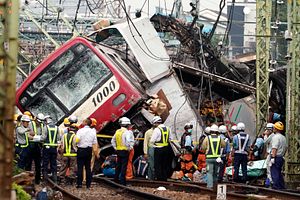Last week, Japan’s renowned train safety reputation took a hit following a major crash with an oncoming cargo truck that derailed the train’s first three carriages, leaving the lead carriage badly twisted, smashing carriage windows, and bending an overhead power line.
An express passenger train moving at 120 kph collided with a 12-meter truck at a level crossing, killing the 67-year-old truck driver and injuring 34 of the 500 passengers on board in Yokohama, south of Tokyo. One passenger was reported to suffer serious injuries, while the majority reported minor injuries. The impact of the crash set the truck on fire sending black fumes billowing from the site.
The truck, carrying 12 tonnes of lemons and oranges, attempted to make a right turn but got caught on the tracks in the narrow 11-meter wide crossing. The truck company said the crossing was not part of the instructed route, suggesting the driver may have taken the wrong road.
The 28-year old train driver said the emergency brake was applied immediately after seeing the obstacle detection signal at least some 600 meters away from the crossing. However, some experts refute the driver’s brake timing. The central government’s Japan Transport Safety Board (JTSB) and Kanagawa prefecture police are investigating whether the accident could have been prevented and are analyzing data to determine when exactly the driver applied the brakes.
The obstacle detection equipment at the crossing comprises of sensors that detect irregularities then notify the approaching train via three traffic lights posted at 10 meters, 130 meters, and 330 meters from the rail crossing. If the driver notices the first signal the train is designed to stop around 10 meters before the crossing, even at maximum speed, drawing attention to contradictions in the driver’s statement.
Some railway companies have introduced a system that automatically brakes when an obstacle is detected. But Keikyu has justified manual braking to prevent the train braking at locations dangerous to evacuating passengers such as tunnels or bridges. Police say the driver is under suspicion for negligence causing injury and death under the “Automobile Driving Punishment Law.”
The accident has sparked outrage over the state of level crossing safety and “unopened level crossings” in traffic-congested routes. The Tokyo metropolitan area has the highest density of railroads in the world. There are a whopping 620 level crossings in Tokyo, compared to 48 in New York, 13 in London, and seven in Paris.
Areas where traffic is most concentrated, such as metropolitan Tokyo and Yokohama in Kanagawa prefecture, are most at risk of rail crossing accidents. The Ministry of Transport describes “unopened level crossings” as overburdened crossings inaccessible to cars and pedestrians for 40 minutes or more. The crossing at the crash site is reported to remain closed for 48 minutes during peak times. Ministry data show 532 crossings that are left unopened for more than 40 minutes, with 70 percent concentrated in the Tokyo metropolitan area.
Efforts to abolish dangerous railway crossings were targeted under the “Crossing Improvement Promotion Act” implemented in 2016. However, with 30,000 submissions for improvement work and maintenance, only 1,000 locations were selected and the crossing at the accident site was overlooked.
The enormous costs of installing bridges remain a contentious political issue, with estimates toward bridge constructions starting at billions of yen per location, which train companies are reluctant to fork out. The cheaper alternative commonly adopted is a green demarcation strip that distinguishes motorways from sidewalks. But in terms of preventing accidents at level crossings closed for long periods of time, it goes without saying that this is far from a radical solution.

































